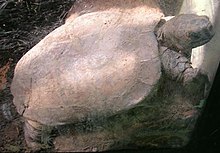Arakan forest turtle
| Arakan forest turtle | |
|---|---|
 |
|
| Specimen at Atlanta Zoo | |
| Scientific classification | |
| Kingdom: | Animalia |
| Phylum: | Chordata |
| Class: | Reptilia |
| Order: | Testudines |
| Suborder: | Cryptodira |
| Family: | Geoemydidae |
| Genus: | Heosemys |
| Species: | H. depressa |
| Binomial name | |
|
Heosemys depressa (Anderson, 1875) |
|
| Synonyms | |
|
|
The Arakan forest turtle (Heosemys depressa) is a really rare turtle species which lives only in the Arakan hills of western Myanmar and the bordering Chittagong Hill Tracts of Bangladesh. The Arakan forest turtle is a semiterrestrial turtle, meaning it can survive in aquatic as well as terrestrial habitats, but as adults, they prefer living in terrestrial habitats.
The turtle remains dormant the majority of the time by hiding in leaves and debris if they are not foraging for food. The Arakan forest turtle is an omnivore, feeding on both animals and plants. Although these turtles are considered a relatively reserved animal for the majority of their daily activity, they are aggressive when it comes to eating insects, worms, and fish. They also consume fruit that falls to the forest floor.
The Arakan forest turtle was believed extinct (last seen in 1908), but in 1994 was rediscovered when a few specimens turned up in Asian food markets. Like most Asian turtles, it is collected yearly as a food source or for "medical cures". Only a handful of these conservation-reliant turtles are in captivity, and their status in the wild, which is dubious at best, is listed as critical.
"The animals seem to be extremely difficult to establish in captivity," said Peter Paul van Dijk, director of the tortoise and freshwater turtle program for Conservation International. Only 14 Arakan forest turtles are housed in Association of Zoos and Aquariums-accredited institutions in the United States, at Zoo Atlanta, the St. Louis Zoo, the Miami Metro Zoo, River Banks Zoo and Garden in Columbia, South Carolina, and the Knoxville Zoo.
In May 2007, Zoo Atlanta, the only Arakan forest turtle breeding facility in the world, announced the successful hatching of the fourth hatchling to have been born there in the last six years. They also announced another egg was near hatching, and two additional hatchlings did not survive. Arakan forest turtles only mate once a year, and the eggs take 100 days to hatch.
Between January 21, and February 14, 2000, a group of scientists participated in an expedition to central Rakhine, formerly Arakan, State in the western part of Myanmar, formerly Burma, to gain information on the Arakan forest turtle. The expedition yielded one male Arakan forest turtle, with a carapace length of 22.cm, a mass of 1.3 kg, and 18 plastral annuli. It was discovered by a hunter’s dog on 7 February about 30 m from a small stream in bamboo forest on Salu Taung, along the Arakan Yoma. The carapace was severely damaged with signs of abnormal healing.
...
Wikipedia

